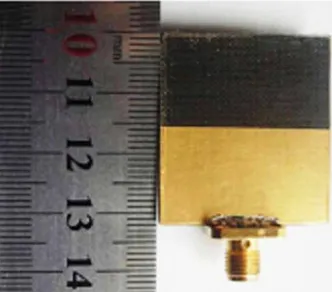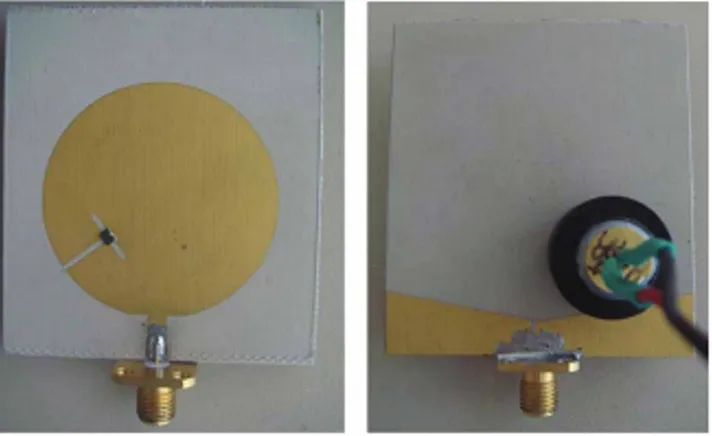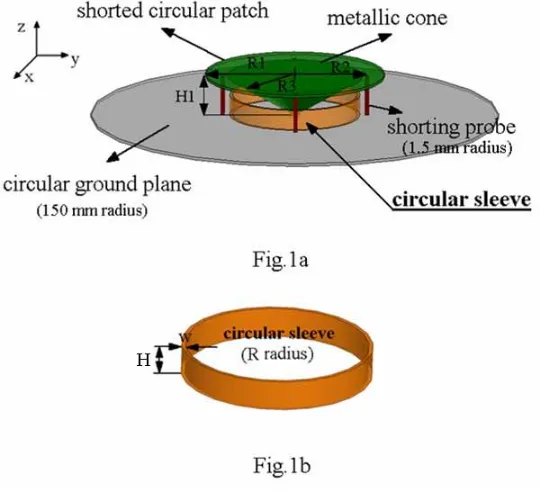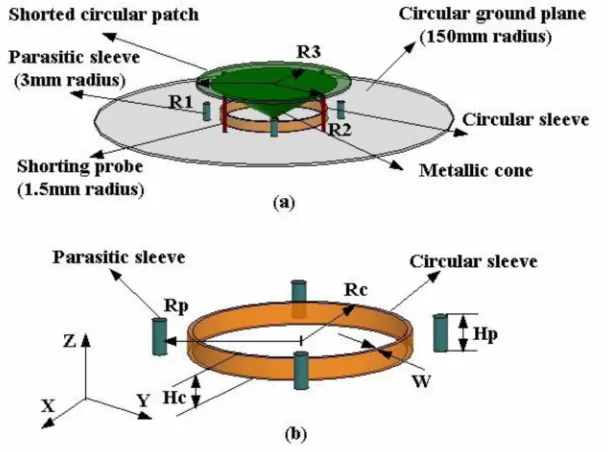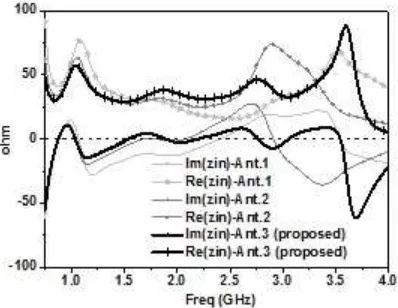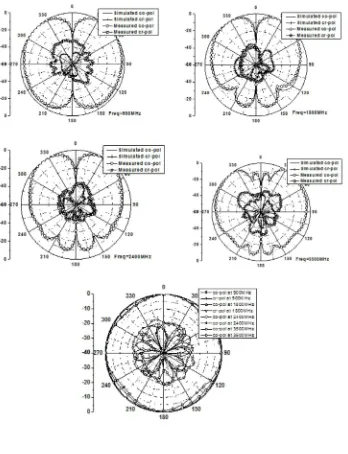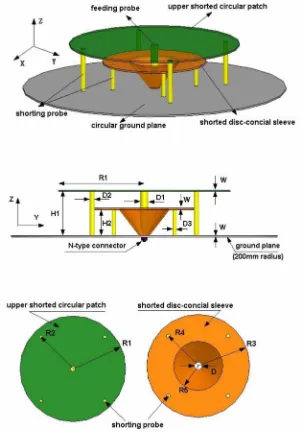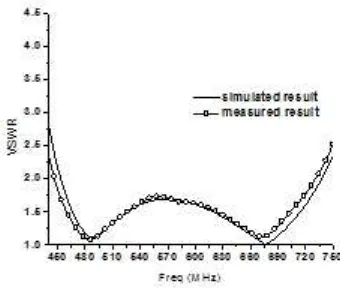Mohammad A. Matin
Institut Teknologi Brunei, Brunei Darussalam
Wideband, Multiband,
and Smart Reconfigurable
Antennas for Modern
Published in the United States of America by
Information Science Reference (an imprint of IGI Global) 701 E. Chocolate Avenue
Copyright © 2016 by IGI Global. All rights reserved. No part of this publication may be reproduced, stored or distributed in any form or by any means, electronic or mechanical, including photocopying, without written permission from the publisher.
Product or company names used in this set are for identification purposes only. Inclusion of the names of the products or companies does not indicate a claim of ownership by IGI Global of the trademark or registered trademark.
Library of Congress Cataloging-in-Publication Data
British Cataloguing in Publication Data
A Cataloguing in Publication record for this book is available from the British Library.
All work contributed to this book is new, previously-unpublished material. The views expressed in this book are those of the authors, but not necessarily of the publisher.
Wideband, multiband, and smart reconfigurable antennas for modern wireless communications / Mohammad A. Matin, editor.
pages cm
Includes bibliographical references and index.
ISBN 978-1-4666-8645-8 (hardcover) -- ISBN 978-1-4666-8646-5 (ebook) 1. Adaptive antennas. 2. Wireless communication systems--Equipment and supplies. 3. Cell phone systems--Equipment and supplies. I. Matin, Mohammad A., 1977-
TK7871.67.A33W53 2016 621.3841’35--dc23
2015015762 Managing Editor:
Editorial Advisory Board
Christos N. Capsalis, National Technical University of Athens, Greece
Bernard Huyart, Telecom ParisTech, France
Monai Krairiksh, King Mongkut’s Institute of Technology, Thailand
Tharek Abd Rahman, Universiti Teknologi (UTM), Malaysia
Eva Rajo-Iglesis, Carlos III University, Spain
Abdel-Razik Sebak, Concordia University, Canada
List of Reviewers
Qammer Hussain Abbasi, Texas A&M University at Qatar, Qatar
Anargyros Baklezos, National Technical University of Athens, Greece
Yvan Duroc, University Claude Bernard Lyon 1, France
Rupesh Kumar, Telecom ParisTech (ENST), France
Christos Nikolopoulos, National Technical University of Athens, Greece
Atiqur Rahman, North South University, Bangladesh
Masood Ur Rehman, University of Bedfordshire, UK
Kumaresh Sarmah, Gauhati University, India
Preface
;...xiii
;Acknowledgment
;...xviii
;Chapter 1
;Recent Trends in Antennas for Modern Wireless Communications
;... 1
;Mohammad Abdul Matin
;, Institut Teknologi Brunei, Brunei Darussalam
;Chapter 2
;Broadband Antennas
;... 27
;Zhiya Zhang
;, Xidian University, China
;Masood Ur-Rehman
;, University of Bedfordshire, UK
;Xiaodong Yang
;, Xidian University, China
;Erchin Serpedin
;, Texas A&M University, USA
;Aifeng Ren
;, Xidian University, China
;Shaoli Zuo
;, Xidian University, China
;Atiqur Rahman
;, North South University, Bangladesh
;Qammer Hussain Abbasi
;, Texas A&M University at Qatar, Qatar
;Chapter 3
;High-Gain Broadband Antennas for 60-GHz Short-Range Wireless
Communications
;... 72
;Osama Haraz
;, Assiut University, Egypt
;Sultan Almorqi
;, King Abdul-Aziz City for Science and Technology
(KACST), Saudi Arabia
;Multiband Antenna for Modern Wireless Communication
;... 123
;Nassrin Elamin
;, International University of Africa, Sudan
;Tharek Rahman
;, Universiti Teknologi Malaysia (UTM), Malaysia
;Chapter 5
;MIMO Antennas
;... 145
;Eva Rajo-Iglesias
;, Carlos III University, Spain
;Mohammad S. Sharawi
;, King Fahd University of Petroleum and
Minerals (KFUPM), Saudi Arabia
;Chapter 6
;Limited Size MIMO Antenna Systems and Mutual Coupling Challenge
;... 176
;Nassrin Elamin
;, International University of Africa, Sudan
;Tharek Rahman
;, Universiti Teknologi Malaysia (UTM), Malaysia
;Chapter 7
;Reconfigurable Antennas: Theory and Techniques – A Survey
;... 203
;Christos D. Nikolopoulos
;, National Technical University of Athens,
Greece
;Anargyros T. Baklezos
;, National Technical University of Athens, Greece
;Christos N. Capsalis
;, National Technical University of Athens, Greece
;Chapter 8
;Reconfigurable Antenna: Narrowband Frequency Reconfigurable Antenna
;... 237
;Mohamad Kamal A Rahim
;, Universiti Teknologi Malaysia, Malaysia
;Huda A. A. Majid
;, Universiti Teknologi Malaysia, Malaysia
;Mohamad Rijal Hamid
;, Universiti Teknologi Malaysia, Malaysia
;Chapter 9
;Reconfigurable Antennas for Cognitive Radio: Classification and
Reconfiguration Techniques – Examples and Case of a Frequency
Reconfigurable PIFA Antenna System Using a Microcontroller
;... 264
;Trong Duc Nguyen
;, Vietnam Maritime University, Vietnam
;Yvan Duroc
;, University Claude Bernard Lyon 1, France
;Tan-Phu Vuong
;, Grenoble INP, France
;Chapter 10
;Novel Nature-Derived Intelligent Algorithms and Their Applications in
Antenna System and Architecture-Circular Polarized UWB Antenna for
Indoor Positioning Application
;... 340
;Rupesh Kumar
;, Telecom ParisTech, France
;Bernard Huyart
;, Telecom ParisTech, France
;Jean-Christophe Cousin
;, Telecom ParisTech, France
;Preface
;...xiii
;Acknowledgment
;...xviii
;Chapter 1
;Recent Trends in Antennas for Modern Wireless Communications
;... 1
;Mohammad Abdul Matin
;, Institut Teknologi Brunei, Brunei Darussalam
;The rapid development in wireless communications has demanded multiband
or wideband antennas to support wireless communication devices such as smart
phones, tablets, laptop computers, radar system, satellite communication, airplane,
and unmanned airborne vehicle (UAV) radar. It has also demanded compact wireless
devices that allow more space to integrate other electronic components. The aim of
this chapter is to provide an idea of current R&D trends and novel approaches in
design, analysis and synthesis of broadband, multiband and reconfigurable antennas
for the new generation of mobile communication devices, as well as for UWB
communications, radars and so on.
;Chapter 2
;Broadband Antennas
;... 27
;Zhiya Zhang
;, Xidian University, China
;Masood Ur-Rehman
;, University of Bedfordshire, UK
;Xiaodong Yang
;, Xidian University, China
;Erchin Serpedin
;, Texas A&M University, USA
;Aifeng Ren
;, Xidian University, China
;Shaoli Zuo
;, Xidian University, China
;Atiqur Rahman
;, North South University, Bangladesh
;Qammer Hussain Abbasi
;, Texas A&M University at Qatar, Qatar
;antennas. The broadband antennas that have been discussed in this chapter include:
Low-profile sleeve monopole antenna, Dual-sleeve monopole antenna, Disc-conical
sleeve monopole antenna, Wideband with dumbbell-shaped open sleeve antenna,
Wideband unidirectional patch antenna with Γ-shaped strip feed, Wideband folded
bowtie antenna with Γ-shaped strip feed and tuning stubs, Wideband bowtie antenna
with inverted L-shaped coupling feed and tuning stubs.
;Chapter 3
;High-Gain Broadband Antennas for 60-GHz Short-Range Wireless
Communications
;... 72
;Osama Haraz
;, Assiut University, Egypt
;Sultan Almorqi
;, King Abdul-Aziz City for Science and Technology
(KACST), Saudi Arabia
;Abdel-Razik Sebak
;, Concordia University, Canada
;Saleh A. Alshebeili
;, King Saud University, Saudi Arabia
;This chapter introduces design and implementation of high-gain broadband antennas
for 60-GHz short-range communications. It presents different antenna configurations
and architectures that can be good candidates for the 60-GHz industrial, scientific
and medical (ISM) band. Printed dipole array (PDA) antennas and especially the
Printed log-periodic dipole array (PLPDA) antennas will be discussed in this
chapter. Loading these kind of antennas with low-cost spherical or hemispherical
dielectric lenses will also be presented and demonstrated to increase the gain of
the antenna. Another type of antennas called electromagnetically coupled (EMC)
elliptical patch antenna arrays will be investigated. Antipodal Vivaldi antenna and
corrugated antipodal Vivaldi antenna are also introduced as good candidates for
60-GHz short-range communication applications.
;Chapter 4
;Multiband Antenna for Modern Wireless Communication
;... 123
;Nassrin Elamin
;, International University of Africa, Sudan
;Tharek Rahman
;, Universiti Teknologi Malaysia (UTM), Malaysia
;MIMO Antennas
;... 145
;Eva Rajo-Iglesias
;, Carlos III University, Spain
;Mohammad S. Sharawi
;, King Fahd University of Petroleum and
Minerals (KFUPM), Saudi Arabia
;Multiple-Input-Multiple-Output (MIMO) technology has appeared to overcome
the data throughput limit faced by conventional Single-Input-Single-Output (SISO)
wireless communication systems. In MIMO, a significant increase in the data
throughput is obtained using multiple data streams sent and received by multiple
antenna elements on the transmitter and receiver ends, and this is why fourth generation
(4G) wireless systems are supporting more real time multimedia applications and
videos compared to older generations. The design of MIMO antenna systems is
not a trivial task, and needs careful design practices. Several performance metrics
have been identified for MIMO antenna systems that need to be evaluated on top of
the conventional single element antenna systems. In this chapter, we will start by
giving a brief background on wireless systems evolution and then highlighting the
advantages of MIMO technology and its use in current 4G and future 5G wireless
communication standards. The second section will treat in detail the various
performance metrics that are needed to evaluate the behavior of a MIMO antenna
system. The new metrics that are required for MIMO performance characterization
such as the total active reflection coefficient (TARC) for multi-port antenna systems,
correlation coefficient, diversity gain and channel capacity evaluation will be discussed
in details. Several examples of single-band and Multi-band MIMO antenna systems
are considered next with various types of antenna elements and covering a variety
of wireless applications and device sizes. The chapter ends with a discussion on
some of the challenges encountered in the design of MIMO antennas.
;Chapter 6
;Limited Size MIMO Antenna Systems and Mutual Coupling Challenge
;... 176
;Nassrin Elamin
;, International University of Africa, Sudan
;Tharek Rahman
;, Universiti Teknologi Malaysia (UTM), Malaysia
;and categorized based on the implemented isolation techniques. Furthermore several
MIMO antenna evaluation methods have been discussed.
;Chapter 7
;Reconfigurable Antennas: Theory and Techniques – A Survey
;... 203
;Christos D. Nikolopoulos
;, National Technical University of Athens,
Greece
;Anargyros T. Baklezos
;, National Technical University of Athens, Greece
;Christos N. Capsalis
;, National Technical University of Athens, Greece
;This chapter provides an overview of the demands in today’s technologies and how
reconfigurability contributes in a significant manner. After reviewing the mechanisms
underlying the reconfigurability aspect of the antennas and identifying the challenges,
the chapter provides all current techniques that are used to reconfigure the antenna
parameters for different applications (frequency, radiation pattern, and polarization).
Following the different methods and features characterizing the reconfigurability of
antenna technologies, the chapter delves into the literature and provides an overview
of the most promising techniques. Next, a comparative study of the aforementioned
methodologies is given based on the fundamental reconfigurable principles and
techniques. Closing this chapter, the auspicious approach of variable reactive
loading is discussed. The proposed chapter aims at filling a gap in the literature
and providing the readers (researchers, engineers and business organizations) with
a useful reference.
;Chapter 8
;Reconfigurable Antenna: Narrowband Frequency Reconfigurable Antenna
;... 237
;Mohamad Kamal A Rahim
;, Universiti Teknologi Malaysia, Malaysia
;Huda A. A. Majid
;, Universiti Teknologi Malaysia, Malaysia
;Mohamad Rijal Hamid
;, Universiti Teknologi Malaysia, Malaysia
;Reconfigurable Antennas for Cognitive Radio: Classification and
Reconfiguration Techniques – Examples and Case of a Frequency
Reconfigurable PIFA Antenna System Using a Microcontroller
;... 264
;Trong Duc Nguyen
;, Vietnam Maritime University, Vietnam
;Yvan Duroc
;, University Claude Bernard Lyon 1, France
;Tan-Phu Vuong
;, Grenoble INP, France
;With the development of the cognitive radio, that is a system (transceiver) aware
of its own operational capabilities and needs which aims at a more efficient use of
radio resources (e.g., more universal solution for the co-existence of multiple radio
standards, but also limitation of electromagnetic radiations), the antennas with
reconfiguration capabilities will become unavoidable. This chapter describes the
different types of existing reconfigurable antennas and related approaches allowing
the reconfiguration. The presentation relies on many examples from the literature
and an example of designing a complete system of reconfigurable antenna frequency
is finally detailed.
;Chapter 10
;Novel Nature-Derived Intelligent Algorithms and Their Applications in
Antenna Optimization
;... 296
;Bo Xing
;, University of Limpopo, South Africa
;Antenna System and Architecture-Circular Polarized UWB Antenna for
Indoor Positioning Application
;... 340
;Rupesh Kumar
;, Telecom ParisTech, France
;Bernard Huyart
;, Telecom ParisTech, France
;Jean-Christophe Cousin
;, Telecom ParisTech, France
;Indoor environment can be characterized as sever attenuating and depolarizing
medium for electromagnetic (radio) waves propagation. These signals are radiated
from transmitters to space (free-space propagation channel) and received from space
to receivers through antennas. These signals are commonly radiated or received
with pre-defined signal’s polarization schemes and these schemes are always
controlled by the antenna. In this chapter, the two-dimensional antenna designs
and its polarization schemes are presented for minimizing the sever effects of an
indoor environment. Emphasis is on understanding the special attention required
for designing an antenna dedicated to an Indoor Positioning/Localization System.
Some recent developments in antenna designs are presented as an example for the
better understanding and its future perspective.
;Compilation of References
;... 362
;About the Contributors
;... 408
;Preface
bandwidth and achievable gain. As a result, innovative solutions are required to
reduce the degree of complexity and difficulty in the design of wireless device
antenna systems.
The objective of this book is to present current R&D trends and novel approaches
in design, analysis of broadband, multiband, and reconfigurable antennas for wireless
and UWB applications, as well as to the identification of integration techniques.
This book provides theoretical and experimental approach to some extent that is
more useful to the reader. Also highlights unique design issues to help the reader
to be able to understand more advanced research.
It is worth mentioning that 27 chapter proposals were received from 18
differ-ent countries (China, Australia, Qatar, Saudi Arabia, Canada, France, Bangladesh,
Hong Kong, Greece, India, Malaysia, Spain, Brunei Darussalam, Thailand, South
Africa, Singapore, United Kingdom and United States of America) for this book.
A rigorous review process was enforced with the help of 10 experts, almost all of
them with a PhD in topics related to the book.
After reviewing the chapter proposals and complete chapters, 11 were accepted
to be published (41% acceptance ratio). All authors and coauthors (except two) of
the accepted chapters are holding PhD.
Chapter 1 provides an idea of current research trends and novel approaches in
design, analysis and synthesis of broadband, multiband and reconfigurable
anten-nas for the new generation of mobile communication devices, as well as for UWB
communications, radars and so on. The modern wireless devices will operate in
smart cognitive systems, switches to different bands with a single terminal antenna
to optimize services on the different radio standards. In this chapter, some of the
latest advances in wideband, multiband and reconfigurable antenna technology
have been also described.
Chapter 2 discusses the design idea, structure and working mechanism of
vari-ous wideband antennas including low-profile sleeve monopole antenna, dual-sleeve
monopole antenna, disc-conical sleeve monopole antenna, wideband with
dumbbell-shaped open sleeve antenna, wideband unidirectional patch antenna with Γ-dumbbell-shaped
strip feed, wideband folded bowtie antenna with Γ-shaped strip feed and tuning stubs,
wideband bowtie antenna with inverted L-shaped coupling feed and tuning stubs.
good candidates for 60-GHz short-range communication applications. Detailed
comparisons is carried out among those entire antennas in terms of size, impedance
bandwidth, gain, radiation efficiency, total efficiency, half power beam width, side
love levels (SLLs), front-to-back (FTB) ratio, cross-polarization levels (XPLs),etc.
Chapter 4 discusses few issues in designing multiband antenna which includes
size reduction required by the limited size wireless devices against the antenna
ef-ficiency, the complexity and difficulty in adjusting the multi resonating system to
match the required frequency bands. Three new multiband antennas were presented
to successfully demonstrate the multiband characteristics. Consequently,
innova-tive solutions are presented to reduce the degree of efficient power complexity and
difficulty in the design of wireless device antenna systems. Therefore two, three,
and four separated bands antennas have been discussed and present their simulated
and measured results.
Chapter 5 highlights the advantages of MIMO technology and its use in current
4G and future 5G wireless communication standards. It provides the various
perfor-mance metrics that are needed to evaluate the behavior of a MIMO antenna system.
The new metrics for MIMO performance characterization such as the total active
reflection coefficient (TARC) for multi-port antenna systems, correlation coefficient,
diversity gain and channel capacity evaluation are also discussed in details. Several
examples of single band and Multi-band MIMO antenna systems are considered next
with various types of antenna elements covering a variety of wireless applications
and device sizes. This chapter is concluded with some general design guidelines for
practicing engineers and researchers involved in MIMO antenna design.
Chapter 6 presents miniature high isolated MIMO antenna system. A practical
MIMO antenna system should have a low signal correlation between the antenna
elements and good matching features for input impedance. Moreover, MIMO system
performance can be improved by reducing mutual coupling between closely spaced
antenna elements. Furthermore, several MIMO antenna evaluation methods have
been discussed in this chapter. It is difficult to evaluate and compare the mutual
coupling isolation techniques used in MIMO antenna due to the conflicting
indi-vidual characteristics (such as operating frequency, antenna area, and the achieved
isolation value S12). Therefore, this chapter concludes by recommending a new
method to evaluate isolation methods and MIMO antenna systems.
fundamental reconfigurable principles and techniques. This chapter concludes with
a discussion of the promising approach of variable reactive loading. The ultimate
goal of this chapter is to provide a detailed survey of reconfigurable antennas to the
readers (researchers, engineers and business organizations) which might be useful
as reference for them.
Chapter 8 presents two new design of narrowband to narrowband frequency
reconfigurable slot antenna. For the first reconfigurable antenna, a compact
mi-crostrip slot antenna is used to reconfigure six different narrow bands. The authors
have achieved 33% size reduction with the bending of slot and transmission line. In
addition to size reduction, an easy and compact biasing circuit is integrated into the
ground plane which does not affect the performances of the antenna. The second
reconfigurable antenna is a combination of microstrip patch and slot antenna. The
slot is positioned in the ground plane, underneath the patch. The combination of
these two antennas has the potential to provide extra functionality as each antenna
has its own characteristics in term of frequency and radiation pattern. The simulated
and measured results are used to demonstrate the performance of these antennas.
Chapter 9 provides an overview of different types of reconfigurable antennas
and illustrates how a complete reconfigurable antenna system can be designed by an
example using basic components (PIFA antenna, PIN diode and microcontroller). In
this chapter, the complete 8-shape RPIFA antenna system is simulated, optimized
and realized. An AVR microcontroller is integrated onboard with the antenna. The
control of PIN diodes is carried out through programs in the memory in the AVR.
The combination of AVR, PC and ED allows that the AVR processes the data
ob-tained from those devices and produces feedback signals, which then automatically
corrects the antenna and allows an adaptive operating system like in cognitive radio.
In summary, we can say that this chapter better defines the role and the principle
of reconfigurable antennas which provides ways for the design of future antennas
dedicated to cognitive radio.
Chapter 10 provides an overview of nature-inspired algorithms which analyze and
synthesize antenna characteristics in a meaningful manner. Traditional approaches
to this topic are based on simplified electromagnetic calculations which can only
approximate real antenna performance. Currently, nature-derived computational
in-telligent methods are used to facilitate improved antenna design using mathematical
optimization techniques before construction. Among the presented algorithms in this
chapter, the invasive weed optimization (IWO) is very suitable for electromagnetics.
In addition, some new optimization methods such as biogeography-based optimization
(BBO), seeker optimization algorithm (SOA), and central force optimization (CFO)
are likely be an attractive alternate in the electromagnetics and antennas research.
po-sitioning. This chapter also talks about the difference between circular polarization
and linear polarization as well as the advantages of the former compared to later one
in an indoor environment. The propagation of radio wave usually suffers multiple
reflections which lead to signal depolarization along with strong signal attenuations
because of the presence of dense clutters such as walls, floors, furniture, doors, etc.
The use of circular polarization gives more chance of signal reception as it uses all
planes during propagation whereas linear polarization remains confined in a given
single plane. Following the above discussion, two-dimensional antenna designs and
its polarization schemes for minimizing the sever effects of an indoor environment
are presented for indoor positioning/Localization System. Some recent developments
in antenna designs are also presented as an example for the better understanding
and its future perspective.
This book attempts to present current and emerging trends in research and
de-velopment of wideband, multiband, and smart reconfigurable antennas for modern
wireless communications featuring a structured approach. Features include:
•
Reviews design methodologies as well as offering an in-depth treatment
of wideband, multiband and reconfigurable antennas for modern wireless
communications.
•
Provide up-to-date materials for wideband, multiband antennas and practical
design information and extensive discussion.
•
Include an extensive survey of broadband, MIMO and reconfigurable
anten-nas literature published over the past several years.
•
Presents simulation and experimental results to illustrate concepts.
•
The chapters are written by experts at the forefront of antenna research,
high-light current design and engineering practices, emphasizing challenging
is-sues related to antennas for modern wireless applications.
•
The book includes more than 180 illustrations and analytical techniques for
all types of broadband and multiband antennas which is reference for R&D
organizations, researchers, practitioners, consultants, RF professionals and
communication engineers.
•
This book supplements its content with extensive references to enable
re-searchers for further investigation of broadband, multiband antennas and
applications.
It is also hoped that this book will serve as a comprehensive reference for
gradu-ate students who wish to enhance their knowledge of all aspects of antennas for
wireless communications.
Mohammad A. Matin
Acknowledgment
DOI: 10.4018/978-1-4666-8645-8.ch001
Chapter 1
Recent Trends in
Antennas for Modern
Wireless Communications
ABSTRACT
The rapid development in wireless communications has demanded multiband or
wideband antennas to support wireless communication devices such as smart phones,
tablets, laptop computers, radar system, satellite communication, airplane, and
unmanned airborne vehicle (UAV) radar. It has also demanded compact wireless
devices that allow more space to integrate other electronic components. The aim of
this chapter is to provide an idea of current R&D trends and novel approaches in
design, analysis and synthesis of broadband, multiband and reconfigurable
anten-nas for the new generation of mobile communication devices, as well as for UWB
communications, radars and so on.
1. INTRODUCTION
The world is undergoing a major wireless revolution both in terms of wireless and
mobile technology that provides ubiquitous communication access to citizens (Matin,
2012). As the society moves forward to the information centricity, the wireless
communication industry brings new product with advance feature to support
wire-less services at any where, any time. The huge competition in the wirewire-less industry
and the mass acceptance of wireless devices have caused costs associated with the
Mohammad Abdul Matin
terminals and air time to come down significantly in the last 10 years. However, the
rapid development of the communication technology such as wearable computers,
cell phone technology, Personal Area Networks (PANs) for remote retrieval and
monitoring of surroundings information has demanded for antennas suitable to
operate with dual or multi-bands characteristics in wireless communication devices.
For example, mobile communication system which operates in different frequency
ranges require multiband antenna. Concurrently, ultrawideband (UWB) systems
used in short range communications, remote sensing, and through-the-wall radar
imaging require wideband antennas with stable gain and linear phase characteristics
which creates a new arena of antenna design. Moreover, recently, there has been
tremendous research interest in designing compact size of antenna in order to offer
more space to integrate other electronic components for reduction the volume of
wireless devices. All these desirable attributes push the researcher into challenge
in designing new broadband, multiband and reconfigurable antennas for the new
generation of mobile communication devices, as well as for UWB communications,
radars and so on. This chapter provides an idea of current R&D trends in design,
analysis and synthesis of broadband, multiband and reconfigurable antennas for
modern wireless communications.
To facilitate the idea of current R&D trends towards different wireless
applica-tions, this chapter is organized as follows. In section 2, different design approaches
are discussed for mobile and wireless applications. A low-profile multiband loop
antenna design is presented for wireless routers and access points to cover the
op-eration bands of 3G, 4G, WiMAX, and WLAN. This section also describes MIMO
antenna on laptop for multiband LTE services. For radar applications, few antenna
prototypes are presented in section 3. Section 4 describes the features of most recent
antennas for UWB applications. In addition, this chapter also describes wearable
antennas. The wearable antennas have gained a lot of attention due to its potential
applications in healthcare, entertainment, identification systems, sport, smart home,
and space in section 5. The presented antenna offers good integration features that
make it suitable for on-body devices.
2. ANTENNAS FOR 3G, 4G, WiMAX AND WLAN
2.1 Antennas for Mobile Handheld Devices
it provides high data rate services and operates in numerous bands. Thus, this
de-vice creates challenges in implementing antenna for multiple RF bands with a wide
range of frequencies. Furthermore, external to internal multiband antenna designing
in a limited space is also desired. To incorporate the multiband functions, more
than one antenna is required to cover the whole communication bands. However,
antennas have restrictions in size and function. For these reasons, conventional
planar inverted-F antenna (PIFA) has been received attention for mobile handsets.
As a result, most of the conventional multiband internal antennas are in the form
of monopoles or PIFAs (Guo et al., 2004; Wong et al.,2006;Martinez-Vazquez et
al. 2006), but usually narrow-banded and hard to cover the whole communication
bands. Other techniques are, loops (Wong & Huang, 2008) slots (Lin &Wong, 2007;
Wu & Wong, 2008), balanced antennas (Collins et al., 2006), and combinations (Lin
&Wong, 2007; Anguera et al., 2010) for multiband operations.
Multiband antennas can support numerous standards for mobile communication
systems which are in use of different frequency ranges. For example the CDMA800/
GSM900 systems operate in the 824 -960 MHz band, while the WCDMA/CDMA2000
systems operate in the 1880-2170 MHz. The future LTE system will operate in the
2300-2400 MHz and 2550-2690-MHz bands (3GPP, 2010). More standards are
integrated into antennas of the device, such as GSM, 3G, 4G, WLAN, WiMAX, etc.
Therefore, antennas that simultaneously cover the 806-960-MHz and
1880-2690-MHz bands, which can provide 2G/3G/LTE multifunctional services are necessary
for modern communication systems. In this section, we will present few recent
multiband antennas for mobile communications.
A novel design approach shown in Fig.1 for multi-standard mobile handset
antennas is reported and confirmed with experimental results in (Ilvonen et. al.,
2014). The results indicate that the presented antenna operates with better than
3 dB (50%) efficiency across the frequencies of 698–2900 MHz and 3250–3600
MHz, thus providing remarkable performance. The antenna structure is integrated
directly on the printed circuit board and presents better performance with respect to
the state-of-the-art designs presented in the recent publications in terms of antenna
volume, bandwidth and efficiency.
In (Kim et al., 2013), a new multiband microsrtip patch antenna (MPA)
incor-porating inverted-Land T-shaped parasitic elements is proposed to cover Long Term
Evolution time-division duplexing number 34 (LTE TDD No. 34: 2.0175 GHz),
wireless local area network (WLAN: 2.45 GHz), and Worldwide Interoperability
for Microwave Access (WiMAX: 3.5 GHz) bands. The important feature of the
antenna is that it has the capability to tune independent resonant frequencies by
adjusting individual parameters.
Figure 1. (a) Fabricated antenna prototype (b) Schematic view of the antenna
structure. Dimensions are in millimeters
(Ilvonen et. al., 2014).
Figure 2. Fabricated prototype of antenna: (a) showing inverted-L-shaped element;
(b) showing T-shaped element
proposed antenna performs three resonance modes covering six bands of wireless
standards, including GSM, GPS, DCS, PCS, UMTS, and LTE 2300/2500. This
printed PCB multiband antenna reduces the coupling effects of various design
parameters, which is a great advantage in antenna tuning. The presented antenna in
Fig. 3 also shows a better agreement between the simulated and measured return
losses.
A multiband antenna system featuring small coplanar pad elements is proposed
for providing operation at different communication standards. The recent trends are
focused on exciting ground plane radiation modes in order to reduce as much as
possible the volume devoted to the antenna element and the recent studies reveal
that non-resonant antenna elements are preferable for exciting ground plane
radia-tion modes since they maximize the attainable inherent bandwidth. The authors
describe a multiband and small radiating system (Fig. 4) for providing operation at
LTE700, GSM850, GSM900, GSM1800, GSM1900, UMTS, LTE2100, LTE2300,
LTE2500 as well as GPS/Galileo L1/Glonass using coplanar elements in (Anguera
et al., 2013).
A linearly polarized compact multiband multiple-input–multiple-output (MIMO)
antenna system for small mobile terminals which covers GSM850/900, DCS, PCS,
UMTS, WLAN, and WiMAX frequency bands is studied in (Shoaib et al.,2014).
The bandwidth and the respective wireless applications are shown in table 1. The
presented antenna shown in Fig.5 is simple with low-cost design for mobile
termi-nals. However, research is still going on to reduce the width of the printed circuit
board (PCB) by changing the orientation of the antenna elements and the decoupling
structure.
Figure 3. Simulated and Measured return losses of the presented multiband antenna
with three separate resonance modes
The complexity of antenna design for MIMO technology in Long Term
Evolu-tion (LTE) has greatly increased due to requirements of multiple antennas in
lim-ited space while keeping the size of device as small as possible. The design challenge
is severe especially at cellular bands below 1 GHz because of sharing the chassis
as a radiator of multiantennas results in strong mutual coupling, which leads to high
correlation, and hence poor MIMO performance. One approach for getting low
mutual coupling as well as achieving reasonable bandwidth is to utilize multiple
characteristic modes of the chassis for radiation. Once the candidate modes are
selected, appropriate chassis modification can be applied to get better impedance
matching of these modes. To demonstrate these concepts, a dual-band (818–896
MHz, 1841–2067 MHz), dual-antenna prototype was (Fig. 6) designed on a
130
×
60
mm
2chassis for Long Term Evolution (LTE) operation (Miers et al., 2013).
The authors (Fernandez & Sharma,2013) present a low-profile multiband loop
antenna design for wireless routers and access points to cover 3G Universal Mobile
Telecommunications System (UMTS) bands, which include Personal
Communica-tion Service (PCS) and Digital Cellular Service (DCS) bands, 4G Long Term
Evolution (LTE) bands (specifically LTE bands 12, 13, 14, and 17, which are used
Figure 4. Prototype using the four proposed pad elements
(Anguera et al., 2013).Table 1. The bandwidth and the respective wireless applications.
Frequency (MHz) Wireless Applications
826-1005 GSM850 (824-894 MHz)
GSM900 (880-960 MHz)
1527-2480 DCS (1710-1880 MHz), PCS (1850-1990 MHz) UMTS (1920-2170 MHz), WLAN (2400-2480 MHz)
3439-3690 WiMAX (3400-3600 MHz)
for commercial services), Worldwide Interoperability for Microwave Access
(WiMAX) bands, and Wireless Local Area Network (WLAN) bands.
2.3 Mimo Antenna on Laptop for Multiband LTE Services
A compact frequency-reconfigurable MIMO antenna on a laptop is reported for
multiband LTE services in (Mun et al., 2014). It uses a T-shaped dc line and two
p-i-n diodes (D1 and D2) together with the proximity-coupled feed structure. The
presented reconfigurable antenna operates in the LTE 17/13 bands (704–787 MHz) at
State 1 (D1 and D2: ON state) and the LTE 20/7 bands (791–862 MHz, 2500–2690
MHz) at State 2 (D1 and D2: OFF state).
Figure 5. Photograph of the multiband MIMO antenna prototype: (a) top layer and
(b) bottom layer
(Shoaib et al., 2014).
Figure 6.
130
×
60
×
8
mm
3fabricated polycarbonate chassis with 22-mm
3. ANTENNAS FOR RADAR APPLICATIONS
Radars have been widely used in aircrafts, ships, and vehicles to prevent collisions
and to protect lives. The radar based microwaves imaging has also seen an increase
of interest (Fear et al.,2002; Bond et al., 2003; Klemm et al., 2008; Meaney et. al.,
2009; Kurrant et al., 2008; Irishina et al., 2009; Winters et al., 2009; Lim et al., 2008;
Davis et al., 2008; Chen & Kosmas, 2012) for breast cancer detection. However,
radars usually operate in single frequency band, and sometimes they suffer from
the multipath fading and have limited sensitivities. To overcome these weaknesses,
multiband radars arise, and they have been applied in various applications (Chioukh
et al., 2009; Han & Nguyen, 2007; Edrich et al., 2012; Cheong et al., 2014) . To
facilitate the multiband operations, a simple and compact prototype of Yagi–Uda
antenna with good antenna gains is presented in (Costazo, 2013) as shown in Fig.9.
Figure 7. Photograph of the fabricated antenna prototype
(Fernandez & Sharma,2013).Figure 8. Fabricated antenna for measurement: (a) overall view with dc biasing
and (b) detailed view of the T-shaped dc line
This antenna can operate in three different frequency bands, namely 1.9, 2.5, and
3.5 GHz. The drivers are designed in view of classical dipole configuration with
embedded L-shaped slotlines. The function of directors and reflector is to achieve
good directivity over frequency bands of interest. In (Alipour & Hassani, 2008), two
antenna prototypes shown in Fig. 10, respectively, working in P-band and C-band,
are designed, realized, and tested for typical radar applications.
Furthermore, in some radar applications, reconfiguability at antenna level is
often needed for multifunction operation. This feature is achieved by utilizing
an-tenna array systems that can be quickly adapted according to the mission. Therefore,
Figure 9. Photographs of prototyped multiband Yagi–Uda antenna: (a) top view
and (b) bottom view
(Costanzo, 2013).
a control over operating frequency, beam pointing direction, polarization, antenna
gain, and so forth is required.
4. ANTENNAS FOR UWB APPLICATIONS
The selection or the design of antennas is one of the key issues for designing UWB
system because it is one of the most important components in the system. A
well-designed UWB antenna should have a wide bandwidth, a stable gain pattern that
ensures a flat magnitude of the transfer function, and a linear phase response
char-acteristics to minimize the distortion of the transmitted/received pulses.
antenna with multiple notched bands. The use of multiple resonators will increase
the complexity of the UWB system. This has put an additional constraint on antenna
design. Combining a single resonator with UWB antennas to create multi-stopband
antennas is still little reported for such applications in (Sung, 2013). Few latest UWB
antennas are presented in the following section.
In (Li et al., 2013), a printed reconfigurable ultra-wideband (UWB) monopole
antenna with triple narrow band-notched characteristics is presented for cognitive
radio applications.
It is mentioned earlier that the antenna with filtering properties is used to
miti-gate the destructive interference as well as to remove the requirement of additional
bandstop filters. Reconfigurable antennas can have such properties- which are
re-configurable frequency, radiation pattern, polarization, or a combination of these
properties and few planar antennas with reconfigurable band notches have been
proposed (Tawk et al., 2010; Zhang et al., 2008; Al-Husseini et al., 2010) . A
pho-tonically controlled notched band is also presented in (Draskovic et al., 2013). The
main advantage of optically controlled microwave circuits is high level of isolation
between the controlling electronic circuit and the microwave circuit. The photo
conductive silicon switch was mounted across the T shaped slot resonator and used
to activate and deactivate the notch in the antenna response.
Currently, small MIMO UWB antennas have drawn a lot of interest among
re-searchers. In (Daviu et al., 2010), the sizes of the MIMO antennas were
80
×
80
mm. For the rest of these designs, the MIMO antenna proposed in (Zhang et al.,
2009) had the smallest size of
35×40mm. Good isolation was achieved by
insert-ing a tree-like structure between the two antenna elements. In (Liu et al., 2013), an
UWB MIMO antenna with a bandwidth from 3.1 to 10.6 GHz is proposed. It has a
compact size of
26
×
40
mm, about 25% smaller than the one in (Zhang et al., 2009).
Due to promising features of antenna diversity, a new compact coplanar-fed
UWB antenna aimed at applications requiring polarization diversity, like
body-centric and multiple-input–multiple-output (MIMO) communications, is proposed
in (Koohestani et al., 2014) . The radiation pat-terns of the presented antenna
dem-onstrate a good orthogonal polarization operation with the advantage of lower
mutual coupling (isolation≥22 dB) in its entire bandwidth. To the authors’
knowl-edge, this antenna is smaller than the recently designed UWB diversity antennas
fed by CPWs.
5. WEARABLE ANTENNAS
Figure 11. Photograph of the fabricated compact UWB microstrip antenna
(Gautam et al., 2013).Figure 13. (a) Proposed notch element. (b)Proposed UWB antenna with triple
notch bands
(Sung, 2013).
and space. This device needs to be comfortable and attractive for daily wear. It
also requires QOS regardless of the movements of individuals’ or surrounding
ob-jects. Therefore, a huge number of researches are going on for the development of
body-worn wireless networks. Due to the available large on body area, body-worn
devices are not restricted in size and shape (Volakis et al. 2012; Zhang et al., 2012).
Consequently, they are less likely to impose performance restrictions. However, in
comparison to the conventional rigid antennas, body-worn devices require highly
flexible antennas and radio-frequency (RF) circuits with structural integrity. These
requirements motivate the design of antennas using flexible materials (Post et al.,
2000; Hamedi et al., 2007; Ouyang & Chappell, 2008; Morris et al., 2011; wang et
al., 2012; Locher & Troster, 2008; Rais et al., 2013; Wang et al., 2012). Over the last
years, textile antennas have been extensively studied since they guarantee flexibility
and can be directly integrated into the clothing (Hertleer et al., 2007; Hertleer et al.,
2009; Kaivanto et al., 2011; Mantash et al., 2011; Soh et al., 2011, Zhu & Langley,
2009; Liu et al., 2007; Chahat et al., 2011). Several linearly (Hertleer et al., 2007)
and circularly (Hertleer et al., 2009; Kaivanto et al., 2011) polarized fabric-based
patch antennas have been introduced in open literature. Single-band (Zhu & Langley,
2009), dual-band (Liu et al., 2007; Chahat et al., 2011), and ultrawideband (Klemm
& Troester, 2006) textile antennas have also been presented with satisfactory
perfor-mance in free space. Some wearable textile antennas have been also characterized
on the human body (Soh et al., 2011; Zhu & Langley, 2009; Chahat et al., 2011;
Klemm & Troester, 2006). When these antennas are placed close to a lossy medium,
they experience strong radiation pattern distortion, shift in resonance frequency, and
changes in the input impedance. Considering all these issues, Textile antennas need
to be designed. In (Chahat et al., 2012), a textile Yagi–Uda antenna is optimized,
fabricated, and characterized in free space and on a skin-equivalent phantom.
Textile antennas optimized for off-body communications at millimeter waves
have been reported on (Chahat et al., 2012) . On-textile fabrication process is very
challenging at these frequencies, especially due to the roughness of the textile
sur-face and the size of textile fibers and electrotextiles with respect to the geometrical
dimensions of the metallic patterns.
The dual band textile antenna designed in (Paul et al., 2013) for reception of
Digital Television as well as wireless communications, shown in Fig. 18 and
pre-sented in (Paul et al., 2012) is examined.
To cover the Global System for Mobile Communications/personal
communica-tions services/wireless local-area network frequency bands, a novel textile-based
body-worn antenna is reported in (Wang et al., 2014).
The unlicensed 57–64-GHz range provides significant advantages compared
to the lower part of the microwave spectrum. In particular, high data rates can be
reached (up to 5 Gb/s (Baykas et al., 2011) with a high level of security and low
Figure 16. Antenna design. (a) Fabricated antenna. (b) Antenna prototype placed
on a foam support and fed by a V-connector for measurement purpose. (c)Antenna
geometry and dimensions (in millimeters)
Figure 17. Measurement setup on the skin-equivalent phantom for
d
=
0
mm. d
stands for the distance between the ground plane and the phantom
(Chahat et al., 2013).Figure 18. Mounting the textile antenna on the body (a) back (b) forearm (c) back
and covered with sweater
(Paul et al., 2013).

